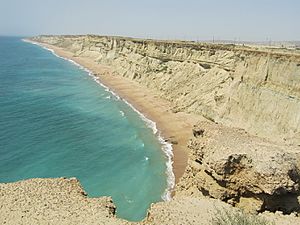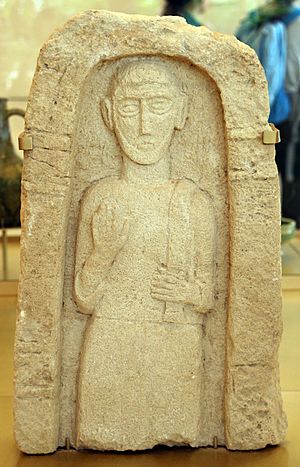Nearchus facts for kids
Nearchus (born around 360 BC – died around 300 BC) was a very important officer in the army of Alexander the Great. He was a navarch, which means he was a top commander of Alexander's navy. Nearchus is most famous for his amazing sea journey. This journey started from the Indus River in India. He sailed through the Persian Gulf and ended at the Tigris River. This long trip happened between 326 and 324 BC, right after Alexander's big campaign in India.
Contents
Early Life of Nearchus
Nearchus was born in Lato, a city on the island of Crete. His father was named Androtimus. At some point, his family moved to Amphipolis in Macedonia. This move happened when Philip II of Macedon, Alexander the Great's father, was king. Nearchus was probably a young boy when they moved.
He was likely older than Alexander. Nearchus was one of Alexander's close friends and mentors. Because of an incident called the "Pixodarus affair," Philip II sent Nearchus and some other friends away from Macedonia. They were allowed to come back only after Philip died and Alexander became king.
Nearchus and Alexander's Conquests
When Nearchus returned, Alexander held him in high regard. In 334/3 BC, Nearchus was made a satrap. A satrap was like a governor of a region. He was put in charge of Lycia and Pamphylia, which are areas in modern-day Turkey. This was one of the first governor jobs Alexander gave out.
Nearchus helped Alexander a lot with his navy. He blocked Persian fleets that were threatening the Aegean Sea. This naval help was key to Alexander's success in conquering Phoenicia, Egypt, and Babylonia. In 328 BC, Nearchus left his governor role. He rejoined Alexander in Bactria, which is in modern-day Afghanistan. He brought more soldiers to help Alexander's army. After a big battle at Aornus in Pakistan, Nearchus led a special mission. He was sent to gather information, especially about elephants.
The Indus River Voyage
In 326 BC, Alexander built a large fleet of ships on the Jhelum River. Nearchus was made the admiral, or commander, of this fleet. However, Nearchus also had to pay for some of the ships himself. Many other commanders in the fleet were not experienced sailors.
The fleet started its journey down the Jhelum River. It looked like a grand parade, with Alexander's army, cavalry, elephants, and treasures moving alongside on land. Where the Chenab River and Indus Rivers met, Alexander founded a new city. He named it Alexandria on the Indus.
Some of the ships were damaged during the journey. Nearchus was told to stay behind to fix them before continuing down the river. This suggests he knew something about building or repairing ships. The voyage down the Indus River lasted from 326 to 325 BC. During this time, they captured several local Indian towns.
By the time the Macedonians reached Pattala (in modern Pakistan), Nearchus got ready for a new mission. He was to lead 17,000 to 20,000 men on an expedition into the Persian Gulf. Alexander, meanwhile, continued his journey through the difficult Gedrosian Desert. Nearchus wrote a detailed account of his journey. This book, called Indica, is now lost. However, parts of it were used by later historians like Arrian and Strabo in their own writings. Nearchus described things like rice, sugarcane, and cotton fabrics in the Indus Valley.
The Persian Gulf Voyage
Nearchus started his journey from Patala. Monsoon rains and strong winds delayed him from reaching the Arabian Sea. To wait out the bad weather, the fleet camped near the mouths of the Indus and Arabius Rivers. They built stone walls for protection and ate mussels, oysters, and razor-fish.
After 24 days, Nearchus continued to the harbor of Morontobara. This is near modern Karachi, Pakistan. A historian named Arrian wrote about this part of the journey. He described how the ships sailed through two very close rocks. The harbor was large, round, and calm, but its entrance was narrow. The locals called it 'The Ladies' Pool'.
The next day, they sailed with an island protecting them from the sea. The island was covered with shady forests. They sailed through a narrow, rough passage and then anchored at the mouth of the Arabis River. There was a good harbor there, but no fresh drinking water. They had to go about 40 stades (about 7 kilometers) inland to find water. Near the harbor was a high, empty island where they found oysters and fish. This was the end of the Indian territory and the start of the land of the Oreitans.
At Morontobara, one of Alexander's generals, Leonnatus, had defeated the local people. He left a supply of food for Nearchus's fleet. After getting supplies, Nearchus reached the Hingol River in Pakistan. He then arrived in the land of the Ichthyophagoi, or 'Fish-Eaters'. These people lived in the dry coastal area of Makran. Nearchus found the harbor of Bagisara, which is modern Ormara Port.
Next, Nearchus and his fleet stopped at several places like Colta, Calima, Carnine, Cysa, and Mosarna. At Mosarna, a local sailor joined them and guided them to Gwadar. There, they found date-palms and gardens. They also explored the city of Chabahar and anchored their fleet at a place dedicated to the Sun God, called Bageia.
Nearchus continued his journey to the Strait of Hormuz, which is the entrance to the Persian Gulf. After many adventures, Nearchus finally reached Carmania, in Southern Iran. Here, he met up with Alexander, who had just crossed the difficult Gedrosian Desert. They noticed that Carmania had good farms with grain, grapevines, and trees. At the Straits of Hormuz, Nearchus and Onesicritus saw the Oman peninsula in Arabia, but they did not go there.
During his voyage, Nearchus is believed to be the first Greek commander to visit Bahrain. The Greeks called Bahrain "Tylos." His visit was the start of Bahrain becoming part of the Greek world. People there even worshipped Zeus, and Greek became the language of the upper classes. Bahrain also held Greek athletic contests. Nearchus wrote that Bahrain was a rich trading island. He said: "That in the island of Tylos, situated in the Persian Gulf, are large plantations of cotton tree, from which are manufactured clothes called sindones, a very different degrees of value, some being costly, others less expensive. The use of these is not confined to India, but extends to Arabia."
The Macedonians visited many ports in the Persian Gulf. These included Harmozeia, Qeshm Island, and places where they met pearl-hunters. They finally reached the mouth of the Tigris River in 324 BC.
After reaching the Tigris River, Nearchus sailed as far as the Euphrates River. Then he turned back to meet Alexander in Susa in early 324 BC. Nearchus and Onesicritus were given golden crowns for their great achievements. Nearchus also married the daughter of Barsine and Mentor. He then took the fleet up to Babylon. There, he passed on a warning from the Chaldeans to Alexander not to enter the city.
Later Life
Nearchus was part of Alexander's final plans. Alexander wanted him to be the admiral of a fleet to conquer Arabia. This was to help trade and transportation in the Persian Gulf between Babylon and India. However, Alexander's death stopped these plans.
After Alexander died, there were arguments over who would rule his empire. Nearchus supported Heracles, Alexander’s son. Later, he joined the side of Antigonus. The last time Nearchus is mentioned is as an adviser to Demetrius in 313/2 BC. What happened to him after that is not known. He probably spent his later years writing his history.
Nearchus wrote a history of his voyages and a description of India. This book was called Indica. Although the original book is lost, we know its contents from other authors. For example, Arrian wrote his own Indica in the 2nd century AD, using Nearchus's work. Pliny the Elder also wrote that Nearchus founded a town called Arbis during his journey.
See also
 In Spanish: Nearco para niños
In Spanish: Nearco para niños





